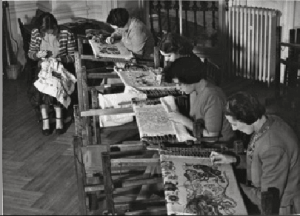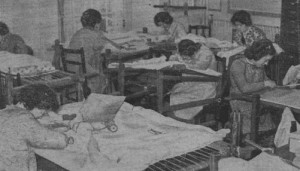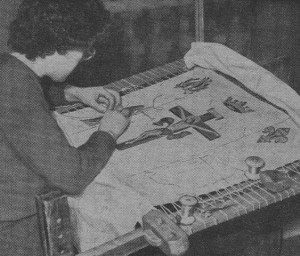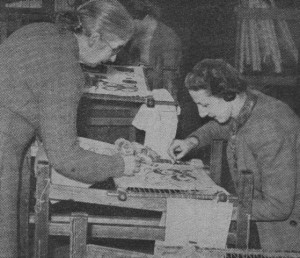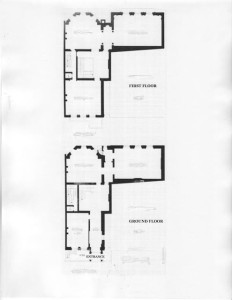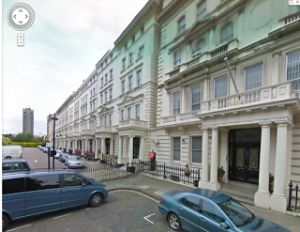Remembering is fun especially when there is someone else to share memories and add to them. I am indebted to Gillian Cox, now Creelman (the dark haired young lady, second from the right in the first class room photo in my July 4 posting). We were both very happy to learn professional techniques from the masters of the art of embroidery but neither of us was particularly happy to discover that, after learning the basics on established samplers, we were expected to design our subsequent pieces of embroidery. These included Long and Short Stitch, Laid Work, Black Work, Coarse and Fine Whitework and Gold Work. How this piece of vital information could have surprised me is now beyond my comprehension. From hindsight, I will also comment that it is hard to design for a technique about which you, as yet, know little or nothing. I still have a mental block about designing but have developed some coping skills.
To aid us in this endeavour, we spent Friday mornings sketching in the Victoria and Albert Museum, the Natural History Museum and, Gillian tells me, she also sketched in Kensington Gardens and Hyde Park but that was after I had left. She remembers, as do I, that passersby would comment on what we were doing as if we were not there or were stone deaf. I dutifully went to the museums and sketched bits of the Syon Cope and stuffed birds but had no idea why I was doing it.
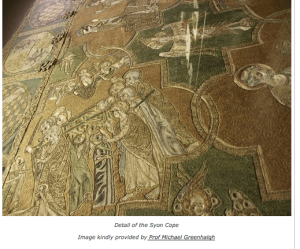
Syon Cope
The Syon Cope is one of England’s treasures. For those who do not know about this remarkable, large piece of embroidery, I will explain why. Made between 1300 and 1320, it is an example of the high degree of artistry and the use of the technique of Underside Couching. Commissioned by wealth it was made by professional stitchers in a workshop. The most expensive of materials was used and it was extremely labour intensive. Underside couching was a specialty of England and is known as Opus Anglicanum. The Syon Cope was taken out of England during the reign of Henry V111 for safe keeping and remained in France until the early 1900s when it was returned. This saved it because otherwise if would have been destroyed and the extensive amount of gold used in the gold thread would have been recycled into the Exchequer. I hope that this information is correct but you can read a lot more about it on the web. I missed the Syon cope when I visited the Victorian and Albert Museum on my last trip to England. The Information Stand that now stands in the main entry hall is not an aesthetic replacement.
The result of being clueless was that when we got to the point of producing a design for the next technique, I was dumbfounded, speechless and without a thought or an idea in my head. Miss Randell coaxed me into some sort of a decision and a design for Regal Lilies using Long and Short Stitched stitched in wool emerged. I had never even seen a Regal Lily and I do not think that anyone else had either. Remember that London was bleak and grey at that time and even the basics of life were in short supply. Available flowers were only those hardy perennials that had survived the war years. My choice was governed by the dream of an unobtainable exotica and the colours. Even after the decision was made, side views and details were guess work. The shading was guided by Miss Randell without whom I would have been totally lost instead of only 98% lost. Now we can turn to Google Images and find a wealth of information and pictures on every subject possible.
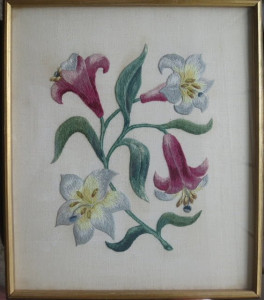
Regal Lilies
I was interested to hear from Marion Scoular, who many of you will know, about her experience of RSN and design. She started her training two years after Gillian and myself. For her first year, Marguerite Randell was her teacher; the second year, Miss Randell moved to the workshop section and Beryl Dean became the senior teacher in the school. Beryl Dean was an RSN graduate but was also an accomplished artist and designer. She tried to change the curriculum and place more emphasis on design. However, the Board of Governors did not agree with her and she only taught there for one year. What a missed golden opportunity that was. Her work is amazing and well worth researching on the web.
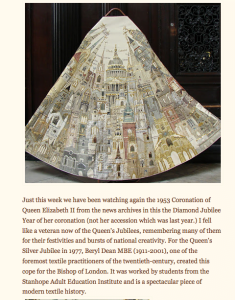
Cope for Bishop of London
When I look at the current RSN students’ gallery, I am totally amazed at the variety and ingenuity displayed. Their work is a lifetime different to anything we ever created.
www.royal-needlework.org.uk Gallery: Degree students work
